A Broadwell Retrospective Review in 2020: Is eDRAM Still Worth It?
by Dr. Ian Cutress on November 2, 2020 11:00 AM ESTCPU Tests: Rendering
Rendering tests, compared to others, are often a little more simple to digest and automate. All the tests put out some sort of score or time, usually in an obtainable way that makes it fairly easy to extract. These tests are some of the most strenuous in our list, due to the highly threaded nature of rendering and ray-tracing, and can draw a lot of power. If a system is not properly configured to deal with the thermal requirements of the processor, the rendering benchmarks is where it would show most easily as the frequency drops over a sustained period of time. Most benchmarks in this case are re-run several times, and the key to this is having an appropriate idle/wait time between benchmarks to allow for temperatures to normalize from the last test.
Blender 2.83 LTS: Link
One of the popular tools for rendering is Blender, with it being a public open source project that anyone in the animation industry can get involved in. This extends to conferences, use in films and VR, with a dedicated Blender Institute, and everything you might expect from a professional software package (except perhaps a professional grade support package). With it being open-source, studios can customize it in as many ways as they need to get the results they require. It ends up being a big optimization target for both Intel and AMD in this regard.
For benchmarking purposes, we fell back to one rendering a frame from a detailed project. Most reviews, as we have done in the past, focus on one of the classic Blender renders, known as BMW_27. It can take anywhere from a few minutes to almost an hour on a regular system. However now that Blender has moved onto a Long Term Support model (LTS) with the latest 2.83 release, we decided to go for something different.
We use this scene, called PartyTug at 6AM by Ian Hubert, which is the official image of Blender 2.83. It is 44.3 MB in size, and uses some of the more modern compute properties of Blender. As it is more complex than the BMW scene, but uses different aspects of the compute model, time to process is roughly similar to before. We loop the scene for at least 10 minutes, taking the average time of the completions taken. Blender offers a command-line tool for batch commands, and we redirect the output into a text file.

Blender is more performance oriented, so we see a more standard performance profile. The Broadwell performs akin to Tiger Lake here only by virtue of the 28W sustained power limit on Tiger Lake.
Corona 1.3: Link
Corona is billed as a popular high-performance photorealistic rendering engine for 3ds Max, with development for Cinema 4D support as well. In order to promote the software, the developers produced a downloadable benchmark on the 1.3 version of the software, with a ray-traced scene involving a military vehicle and a lot of foliage. The software does multiple passes, calculating the scene, geometry, preconditioning and rendering, with performance measured in the time to finish the benchmark (the official metric used on their website) or in rays per second (the metric we use to offer a more linear scale).
The standard benchmark provided by Corona is interface driven: the scene is calculated and displayed in front of the user, with the ability to upload the result to their online database. We got in contact with the developers, who provided us with a non-interface version that allowed for command-line entry and retrieval of the results very easily. We loop around the benchmark five times, waiting 60 seconds between each, and taking an overall average. The time to run this benchmark can be around 10 minutes on a Core i9, up to over an hour on a quad-core 2014 AMD processor or dual-core Pentium.

Similarly, Corona has no need for the eDRAM.
Crysis CPU-Only Gameplay
One of the most oft used memes in computer gaming is ‘Can It Run Crysis?’. The original 2007 game, built in the Crytek engine by Crytek, was heralded as a computationally complex title for the hardware at the time and several years after, suggesting that a user needed graphics hardware from the future in order to run it. Fast forward over a decade, and the game runs fairly easily on modern GPUs.
But can we also apply the same concept to pure CPU rendering? Can a CPU, on its own, render Crysis? Since 64 core processors entered the market, one can dream. So we built a benchmark to see whether the hardware can.
For this test, we’re running Crysis’ own GPU benchmark, but in CPU render mode. This is a 2000 frame test, with medium settings.
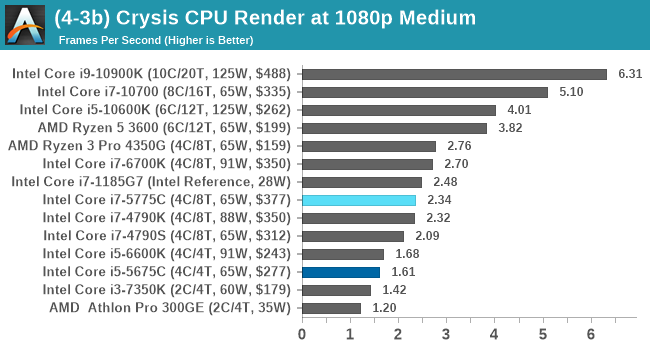
POV-Ray 3.7.1: Link
A long time benchmark staple, POV-Ray is another rendering program that is well known to load up every single thread in a system, regardless of cache and memory levels. After a long period of POV-Ray 3.7 being the latest official release, when AMD launched Ryzen the POV-Ray codebase suddenly saw a range of activity from both AMD and Intel, knowing that the software (with the built-in benchmark) would be an optimization tool for the hardware.
We had to stick a flag in the sand when it came to selecting the version that was fair to both AMD and Intel, and still relevant to end-users. Version 3.7.1 fixes a significant bug in the early 2017 code that was advised against in both Intel and AMD manuals regarding to write-after-read, leading to a nice performance boost.
The benchmark can take over 20 minutes on a slow system with few cores, or around a minute or two on a fast system, or seconds with a dual high-core count EPYC. Because POV-Ray draws a large amount of power and current, it is important to make sure the cooling is sufficient here and the system stays in its high-power state. Using a motherboard with a poor power-delivery and low airflow could create an issue that won’t be obvious in some CPU positioning if the power limit only causes a 100 MHz drop as it changes P-states.
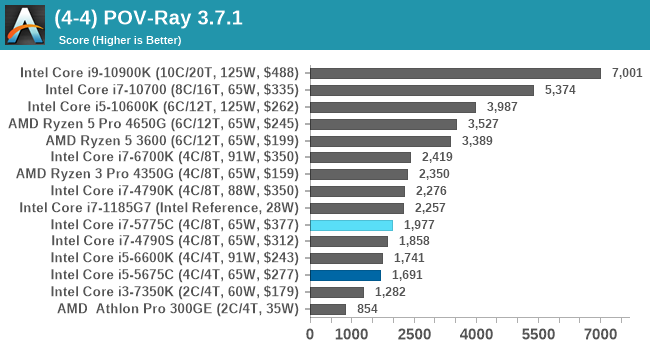
V-Ray: Link
We have a couple of renderers and ray tracers in our suite already, however V-Ray’s benchmark came through for a requested benchmark enough for us to roll it into our suite. Built by ChaosGroup, V-Ray is a 3D rendering package compatible with a number of popular commercial imaging applications, such as 3ds Max, Maya, Undreal, Cinema 4D, and Blender.
We run the standard standalone benchmark application, but in an automated fashion to pull out the result in the form of kilosamples/second. We run the test six times and take an average of the valid results.
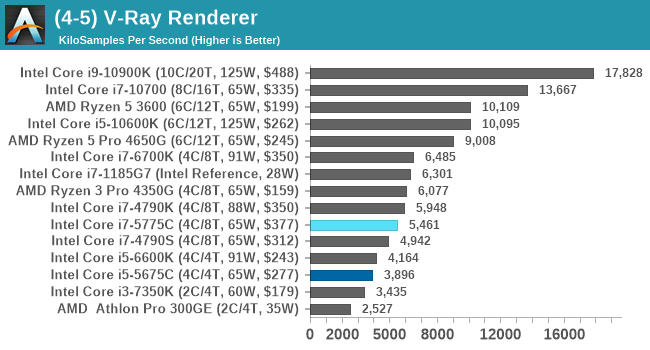
Cinebench R20: Link
Another common stable of a benchmark suite is Cinebench. Based on Cinema4D, Cinebench is a purpose built benchmark machine that renders a scene with both single and multi-threaded options. The scene is identical in both cases. The R20 version means that it targets Cinema 4D R20, a slightly older version of the software which is currently on version R21. Cinebench R20 was launched given that the R15 version had been out a long time, and despite the difference between the benchmark and the latest version of the software on which it is based, Cinebench results are often quoted a lot in marketing materials.
Results for Cinebench R20 are not comparable to R15 or older, because both the scene being used is different, but also the updates in the code bath. The results are output as a score from the software, which is directly proportional to the time taken. Using the benchmark flags for single CPU and multi-CPU workloads, we run the software from the command line which opens the test, runs it, and dumps the result into the console which is redirected to a text file. The test is repeated for a minimum of 10 minutes for both ST and MT, and then the runs averaged.
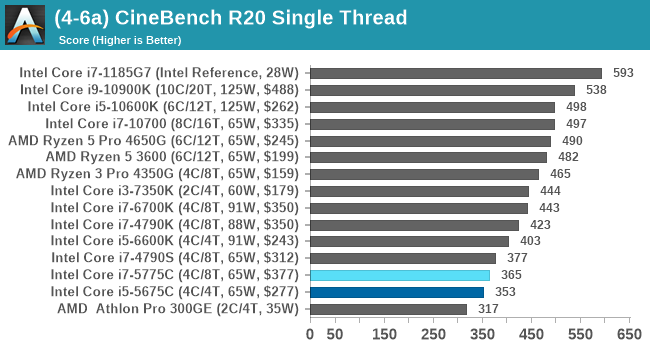
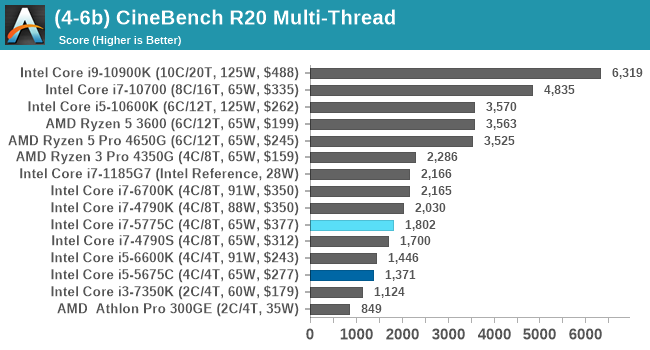






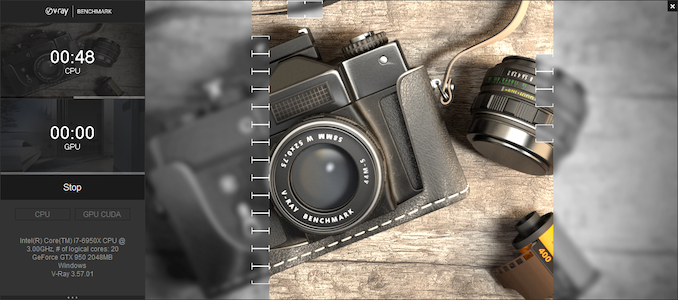









120 Comments
View All Comments
Jorgp2 - Monday, November 2, 2020 - link
Why didn't he buy it then?There was even a many lake refresh
Oxford Guy - Wednesday, November 4, 2020 - link
He didn’t buy a desktop high TDP Skylake with EDRAM because it was never produced. Intel decided to sell less for more, which it could so safely since our capitalist system is mainly about a near-total lack of competition far more often (in tech at least) than anything else. Read for comprehension.Oxford Guy - Monday, November 2, 2020 - link
So, the take-away here is that Intel was heavily sandbagging — not bothering to take advantage of the benefit EDRAM provides (for gaming especially).$10 worth of parts and gamers were expected for fork over big money for less performance.
Hooray for lack of competition.
Nictron - Tuesday, November 3, 2020 - link
My i7 5775c died last week after 4.5 years of service at OC 4.1-4.2 Ghz. Now seeing this review I am quite sad as it could’ve gone a bit more.Upgraded to R5 3600XT for now and can always go 5000 series in future on the X570 platform.
Hope competition stays strong!
Oxford Guy - Wednesday, November 4, 2020 - link
You can hope or you can look at the facts. It hasn’t been strong. That’s why Intel was able to sandbag so extremely.alufan - Tuesday, November 3, 2020 - link
The Intel skew on this site is getting silly its becoming an Intel promo machine!You Benchmark but like many Laptop providers you hamstring the AMD CPU with the worst and slowest components, we all know Ryzen CPUs work best with fast RAM in fact you have stated so yourselves in the past on this very site yet you now choose to test the Ryzen option with CL22 bargain basement RAM..... makes me wonder, how much did Intel pay for this review of a 5 year old CPU just to keep the Blue option at the top of the page, Anandtech is a shameful parody of a neutral review site and frankly the owners and editors have exchanged integrity for well whatever you want to call it, shame on you
Ian Cutress - Tuesday, November 3, 2020 - link
I test at JEDEC speeds. For Ryzen that's DDR4-3200, and JEDEC subtimings are CL22. If you want to complain, complain to JEDEC to ask for something faster, or ask companies to validate memory controllers beyond JEDEC standards. Otherwise it's overclocking, and if we're overclocking, then who cares about core frequency or power anyway.https://www.youtube.com/watch?v=jQe5j7xIcog - I even did a video on it.
I do tons of AMD coverage. Year in year out interviews of CEO and CTO of AMD, but no equivalent of Intel. Deep dives into every major architecture, with analysis of instruction performance as well as cache hierarchy. Reviews of almost every single Ryzen product, as we're sampled most of them. If we were that big of an Intel shill, why does AMD supply us what we ask for?
alufan - Tuesday, November 3, 2020 - link
Ahh so the Ram kit you used for the Intel test just happened to fall into the slots then with its CL16 is that JEDEC standard?I dont want any particular preference shown to either Brand I will admit however to not liking Intel due to former poor experience but I think its important when charts and such are published that a level field is used, because at some point somebody may well use those published figures as a illustration of one products superiority over another, Intel is very good at doing just that, and I will cite the last Thread ripper release for that one just so they could have a set of tables showing the Intel product on the Top even if it was for a few hours.
qwertymac93 - Tuesday, November 3, 2020 - link
Where did you find the latency settings the tests were performed at? I didn't see the latencies mentioned in the test setup page.alufan - Tuesday, November 3, 2020 - link
"Where did you find the latency settings the tests were performed at? I didn't see the latencies mentioned in the test setup page."look up the parts on the makers website